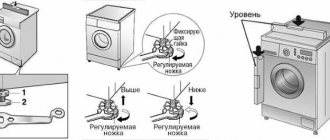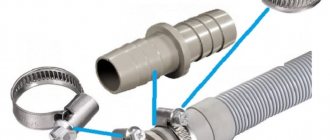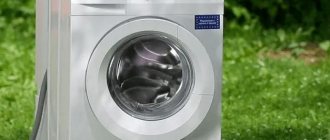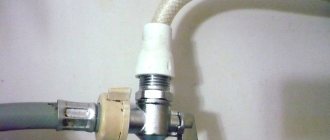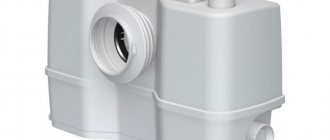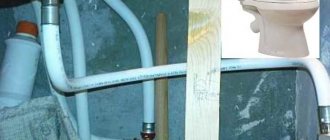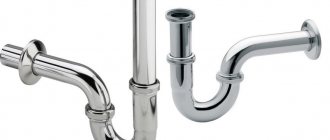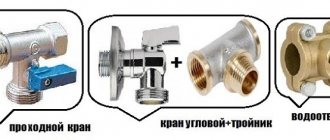Selecting a connection option
Three ways to organize the connection of a washing machine. The choice of one of them depends on your skills in working with tools and plumbing parts.
- Drainage into plumbing fixtures (toilet, bathtub, sink).
- A popular method of connecting to a drain is through a siphon.
- You will need the help of a plumber if the washing machine drain is connected directly to the sewer system.
The drainage device in different ways differs not only in the degree of complexity of the work, but also in its individual pros and cons. In the first case, one cannot talk about the reliability and aesthetics of the process organization. There is a risk that the drain hose mount will come off. Then your own bathroom will be flooded. Not to mention the contaminated surface of the plumbing where waste water from the washing machine will pour out.
Draining water from the washing machine into the sewer through a siphon will save you from unpleasant odors. The third option will, of course, force some tinkering.
Connection to the sewer: methods and options
Once the equipment is in the house, the buyer chooses a suitable place to install it. Here's where washing machines are most often located:
- In the bathroom. A standard option, especially if there is enough space in the room.
- In the kitchen. Significantly simplifies connection due to proximity to the sink.
- In the hall. A rare but possible case if there is no space in other rooms.
In addition to free space, the following factors influence the choice of connection location:
- Location of the washing machine and drain. The fact is that the pump that pumps out the used liquid has its own reserve. And if the distance is too large, then the unit simply will not cope with the task or will quickly wear out.
- Material of pipes in the room. This is if a tie-in is made and a tee is connected.
- Length and diameter of hoses, connections.
How to remove the drain under the washing machine? There are three main ways. Each of them has advantages and disadvantages. You should choose what suits your space and convenience.
Options:
- Draining waste liquid into plumbing fixtures. Each SMA model comes complete with a plastic hook. A hose is installed in it and attached to the edge of the bathtub, sink or toilet. Apart from simple reproduction, the sink drain option no longer has any merit. During the wash, you will not be able to use the plumbing, and after draining, dirt and an unpleasant odor will remain.
- Through a siphon. If a siphon with several outlets is installed under the sink, then simply connect a hose to one of them. But there are pitfalls here too. How to protect your car from sewer odors and dirty water intake? Buy a siphon with both a branch and a check valve.
- Directly into the sewer pipe. To do this, you will have to install an adapter in the pipe. It’s good if the pipes are plastic, but if they are cast iron, you’ll have to work hard or replace this section.
Don't forget about how to properly organize the drain. This concerns the hose placement distance. If the connection is too low, the waste liquid will flow into the tank of the machine. We will describe below how to prevent the problem.
Preparing the washing machine for connection
Whatever option is chosen, it is necessary to prepare the washing machine for installation in a permanent location and connection.
All installation steps are outlined in the instructions. It is important to focus on the fundamental points of the process:
- A washing machine that has just been brought home and brought into the house should sit quietly for some time. Especially if the transportation took place during the cold season. Modern technology is capricious and can break down if started in a cold state.
- The unit must be freed from packaging material. The wooden pallet is carefully removed.
- It doesn’t matter what type of load the purchased machine belongs to, its working unit will be secured during transportation with repair bolts, which are hidden under the plugs. They need to be unscrewed. The location where the plug is installed will be indicated in the instructions. If the bolts are not removed, the machine will break down the first time you start it and the warranty will not be valid. After all, the manufacturer indicates the need to perform this procedure.
- A grounded socket is installed for the washing machine.
- The unit is leveled exactly on the horizon using legs and checked with a building level.
Unscrewed repair bolts are not thrown away. They may come in handy if the machine is transported again to another place.
What happens if the filter is not cleaned?
A dirty trap filter creates serious problems over time:
- Unpleasant odor from the machine and washed clothes
. Debris and dirt stuck in the filter are an excellent breeding ground for germs. The dirty lump begins to sour and smell bad. The smell can penetrate into the tank, and after washing the laundry, instead of a pure aroma, receives a very unpleasant aroma. - Bad drain.
A clog in the washing machine filter prevents normal draining. If the debris is not removed in time, the filter may become so clogged that the washing machine will completely stop draining water from the tank. - Pump failure or breakdown.
There is a possibility that a foreign body may slip from the filter into the pump. This can cause the pump to jam and stop pumping water. In some cases, metal objects break the impeller blades or damage the pump body. As a result, repair or complete repair will be required.
Tools and materials for work
Connecting the washing machine drain to the sewer system begins with preparing a set of tools and materials. You don’t need any special tools and a home kit will be enough:
- set of screwdrivers of different sizes. A cross-head screwdriver is required;
- pliers;
- a set of keys. In the store, check the size of the repair bolts to be sure that you have the right key at home. Otherwise, you must buy it immediately. The most commonly used wrench is a 10mm wrench.
- A drain for a washing machine without a siphon sometimes requires cutting the sewer pipe to size. Then you will need a pipe cutter for the job. But it can be replaced with a hacksaw.
- All parts supplied with the washing machine must include gaskets and seals. For greater sealing, it is better to additionally lubricate them with sealant. A small tube is enough for the job.
- If the drain hose is extended, then it is not advisable to buy it for more than 3 meters. A drain for a washing machine into the sewer with a long hose length will lead to rapid failure of the pump that pumps the drains.
Connecting the device to the sewer
At first glance, the process seems simple, but this is a misconception. Each option has its own nuances.
The connection itself is carried out in two ways:
- Temporary. Then the drain hose is simply lowered into the bathroom or toilet. Suitable if the bath is combined with a toilet.
- Stationary. Here a connection to the sewer is already required. It is this option that causes the most difficulties.
When connecting a washing machine to the sewer, buyers must consider the following requirements and restrictions:
- Long drain hoses are not allowed. Otherwise, the pumps experience increased loads. Because of this, the device fails prematurely.
- There will be no unpleasant odors inside the machine when the drain is connected to the siphon. This is the main advantage of such solutions.
A 50-centimeter distance is optimal for the place where siphons are connected. Then the drainage is carried out correctly. When using a temporary scheme, this rule continues to apply.
The sink siphon must be connected to the drain hose. Only in this case is the tightness of the connection ensured.
Drain connection algorithm
Before draining the washing machine, it is better to measure your strengths and abilities and choose a connection method.
Connection option for a beginner
If a beginner who is far from plumbing takes on the job, or a woman who urgently needs to do laundry, then the easiest option is to use a semicircular nozzle for the plastic drain hose. Organizing this method will not require much time or effort.
- The plastic nozzle resembles a hook. It must be placed on the edge of the drain hose. After this, the “hook” clings to the side wall of the bathtub or the side of the toilet. You can also drain it into the sink.
It is not recommended to use this method constantly. This is most likely an alternative option. During washing, you will not be able to use the plumbing fixtures for their intended purpose.
To avoid the nozzle jumping off the side of the plumbing fixture, it is recommended, for example, to tie it to the faucet in the bathtub. Otherwise, an accident may occur when, from the push of a running pump, the drain hose together with the nozzle will jump off, and water will pour out onto the floor.
If you want to drain conscientiously, then it is better to choose the other two options.
Connection to siphon
The work can be done independently without outside help. A siphon is purchased to connect the washing machine to the sewer, and a ¾-inch metal clamp to tighten the drain pipe. Sometimes the pipe is already built into the siphon structure.
- The plug is removed from the pipe. Its end is coated with sealant.
- A clamp is placed on the drain hose in advance.
- The end of the hose is placed on the pipe and the clamp is tightened with a screwdriver.
You need to be prepared for the fact that during the discharge of waste water, there will be gurgling in the sink and for people who love silence, this can become a problem. If the unit is installed in the kitchen, then sometimes another problem arises. For a washing machine, the diameter of the sewer pipe should be about 50 mm. And in the kitchen, a 30-40 mm pipe is most often installed. A small diameter causes the drains to rise when water is discharged; traces and dirt will remain on the sink.
How to check and replace the pump?
After several years of use, the washing machine may develop problems with draining. Often the elements of the drain system become clogged. A simple cleaning helps to restore the machine’s functionality. Breakdowns also happen. So, the pump may burn out, the pipe may crack. In this case, replacement of elements will be required. To find and fix the problem, you will have to check all components of the drain system.
You can get to the drainage system through the service hatch or the lower decorative panel of the housing.
You can open the door or remove the false panel using a screwdriver. It is necessary to pry off the cover and deal with the latches. Afterwards, the garbage filter and part of the drain pump are inspected. The algorithm of actions will be as follows:
- turn off the power to the washing machine;
- close the valve responsible for the water supply;
- open the hatch or remove the lower decorative panel;
- find the garbage filter;
- Cover the floor around the machine with dry rags, place a low container under the washing machine, in the area where the filter is located;
- Unscrew the trash can plug half a turn. Please note that water will flow out of the hole;
- rinse the drain filter, clean the seat from dirt;
- shine a flashlight into the hole formed - this way you can see the pump impeller;
- remove any debris from the blades;
- Using a long stick, try to spin the impeller - it should move intermittently, but freely.
If the impeller is difficult to move, there is probably a foreign object stuck between the impeller blades. To clean the element, you will have to remove the pump from the housing. This is done as follows:
- Place the machine on its left side. It is better to cover the floor with something soft first;
- if there is a bottom, unscrew the fasteners and remove it;
- find the pump - it is located immediately under the tank.
Before dismantling the pump, it is recommended to check it. Pump diagnostics can be performed using a multimeter. To do this, you need to attach the tester probes to the contacts of the element, set the reading to 700 V on the device, turn on the machine and start the “Drain” mode. After a couple of minutes, you should evaluate the multimeter readings. If the pump does not hum at a voltage of 220 volts, we can talk about its malfunction.
The pump is not repaired; the element will need to be replaced.
To remove the pump, you need to disconnect the pipes and wiring from it, unscrew the bolts holding the pump and remove the element. The new part is fixed in place with self-tapping screws, and the previously discarded chips and hoses are connected to it.
The nuances of connecting the drain
There are certain requirements for the location of the drain hose:
- The drain hose should not lie on the floor after exiting the machine. Before connecting the drain hose to the washing machine, it is hung on the hook, which is located in the upper right corner on the back of the unit. Its other end is directed into the sewer.
- If the machine does not have a check valve, then the edge of the drain hose should be located at least 1.5 m from the floor.
Modern models are equipped with a check valve. If it is not there, it is recommended to install the valve separately. Its price is in the range of 60-100 rubles. The model with a locking ball is the most successful.
Replacing the drain hose
Sometimes it may be necessary to replace the drain hose of the machine. The work is quite simple, even a beginner can handle it. The algorithm of actions will be as follows:
- de-energize the SMA, disconnect it from communications;
- drain the remaining water from the system through a garbage filter;
- move the washing machine away from the wall;
- tilt the machine body to gain free access to its bottom;
- find the place where the hose is fixed on the pump;
- loosen the clamp;
- disconnect the corrugation from the body;
- fix the new hose on the pump, secure it with a clamp;
- connect the corrugation to the body;
- put the machine back in place.
To make sure the replacement is done correctly, run a test wash with the drum empty. Wait until the machine starts draining water. Check that there are no leaks. If drops appear at the joints or the corrugation itself, complete the cycle and tighten the clamps further.
Interesting:
- How does a washing machine drain pump work?
- The principle of operation of the drain pump in a washing machine
- How does a Zanussi washing machine work?
- How does a Kandy washing machine work?
- How does a Samsung washing machine work?
- How does the Atlant washing machine work?
Reader comments
- Share your opinion - leave a comment
How to clean a washing machine drain hose that is completely clogged
During operation, the drainage device of any washing machine accumulates small particles of dust, hair, soap solution, and threads. After a few years, the hose accumulates so much dirt that the water can hardly find its way out. What to do in such a situation and prevent a flood at home? For this purpose, the hose is sanitized.
How to rinse the drainage device of a washing machine according to all the rules?
First, turn off the cold water supply tap and disconnect the machine from the power source. Next, free the drain filter from possible residual water and disconnect the hose from the sewer. The main difficulty is disconnecting the drainage device from the body of the machine. It all depends on the model of the machine.
Next, using a thin cable with a brush at the end, clean the inside of the hose, turning the cable on one side and the other. After freeing the hose from large particles of dirt, it is washed under the tap with hot water several times. Later, all that remains is to put the device in place, secure it tightly and connect it to the sewer.
Connection height
When connecting a drainage system, a parameter such as height must be observed. The pump-out pump has limited power, so the hose must be placed at a height of 80 cm near the machine itself, and at a height of 60 cm or higher near the sewer.
If the hose is positioned lower, the machine pump can wear out quickly. Manufacturers also do not recommend extending the hoses by more than one and a half meters, or using low-quality materials - the pump may work slower or break.
Standards for connecting a washing machine to a siphon
The end of the hose, located at a level of 60 cm from the floor or higher, must be led into the sewer outlet and secured with a cuff or elastic band measuring 3.2x4 cm, overlapping with the pipe. When connecting to the outlet, the hose must not be in the water.
If the outlet is not equipped with a check valve, with an S-shaped connection this effect can be achieved due to the air gap. The lowest part of the hose should be located 50 cm from the floor or higher. If the sewer pipe is located below 50 cm, when connecting a drainage system without a siphon, a “siphon effect” may be created and a constant sewer smell may occur.
How often should you clean the drain filter in your washing machine?
Manufacturers recommend cleaning the filter every 2 to 4 months.
. Focus on the frequency of washing. That is, the more often we use the machine, the more often we clean the filter. For example, when using a machine daily in a large family with children, it is better to clean the filter once a month.
In addition, based on experience in servicing washing machines, it should be noted that the frequency of cleaning the drainage trap also depends on the type of fabric. For example, in winter, woolen and pile fabrics are washed more often: flannel, flannel. They produce a lot of tissue substrate in the form of lint, which clogs the filter. Therefore, the trap should be cleaned more often.
If you are washing something completely trashy, for example, a feather pillow or a down jacket made with natural down, then we recommend cleaning the filter immediately after washing.
